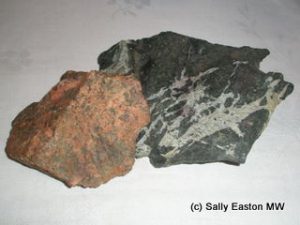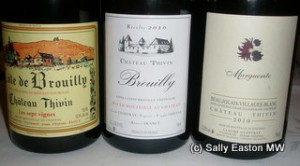Château Thivin

Pink granite and blue volcanic rock
Château Thivin is the oldest estate on the slopes of Mount Brouilly, with part of their cellar dating to 1383.
This excellent property came into the Geoffray family in 1877, when Zaccharie bought the two-hectare estate at the time of the phylloxera crisis. It is now run by Claude Geoffray, father and son: Claude-Vincent the father, and Claude-Edouard, the son and sixth generation.
They work the two most southerly of the ten Beaujolais crus – Côte de Brouilly and Brouilly. Brouilly is also the biggest of the crus, with 1,327ha. Its vineyards surround one of the smallest crus – Côte de Brouilly, with just 322 hectares, at higher altitude up the slopes of the volcanic Mount Brouilly, which peaks at 483m.
Côte de Brouilly is the heart of these two appellations. The bedrock is hard, blue volcanic plutonic rock that formed beneath the earth’s surface and never erupted. It’s the only one of the crus not to be based on granite, though the lieu-dit Côte de Py in Morgon is also volcanic in origin. Geoffray said Côte de Brouilly “has more structure, it’s more serious, and will age longer than Brouilly, which is an easier-drinking” appellation.
The broader Brouilly is based on pink granite, and the Thivins “prefer to drink Brouilly in the first five years, to have the fruity flavours” that they express by using concrete to age this wine. This keeps the freshness and fruitiness more than the oak casks they use for the more serious Côte de Brouilly.
In both their crus, managing gamay’s tannins using semi-carbonic fermentation is a challenging task, so Geoffray said “we taste the juice every day, and if the tannins become too strong we stop the maceration and press. And with more tannin, we give a longer ageing.”

Three generations of label design
The property, which now comprises 25 ha, has three label designs, from 1946, 1976 and 2004, each almost 30 years apart, created by the last three generations. The Côte de Brouilly wines keep the 1946 design, while the Brouilly takes on Claude-Vincent’s design. The more minimalist lines of the new millennium take centre stage for Claude-Edouard’s design.
Chardonnay is a bit of a surprise in Beaujolais, though it represents some 2 to 3% of plantings. The Thivin’s parcel is in Thiezé, in the south of Beaujolais, where the soils are a much better suited clay-limestone mix. Grapes also come from a limestone vein in the village of St-Lager in the Brouilly appellation. The Thivin’s name their chardonnay cuvée after the wife of first generation Zaccharie.
Tasting notes, in situ, December 2011
Château Thivin, Marguerite, Beaujolais Villages Blanc 2010,
Chardonnay from St. Lager, planted in 2000. Vinified and aged in first to fifth use barrel.
Lightest creamy notes, with smooth and supple texture and sweet mediterranean fruits. Fresh, with deep concentration of fruit. Nice.
Château Thivin, Brouilly 2010
Whole bunches for 8 to 12 days, then to stainless steel.
Fresh, dark cherry notes, with a bit of liquorice stick in a medium-bodied wine with nice gentle concentration and balance.
Château Thivin, Cote de Brouilly, Les Sept Vignes, 2010
Whole bunches for 8 to 12 days, and oak casks for six months. “A blend of our parcels, vinified separately, each with different expositions. The top parcels are more mineral and tense. The bottom parcels are easier, rounder and fruitier.”
Hints of aromatic smokiness, purple and dark cherries, smoothly textured, fresh, with hints of graphite. This has a lovely fresh backbone and balance, bright, with violet-perfumed concentration. Vg.
Château Thivin, Cote de Brouilly, Clos Bertrand 2010
This parcel is the historic parcel around the estate, with south west aspect.
Rich, concentrated, lead pencil, violet and dark cherry perfume. Very smoothly textured, silkily-smooth, and sweet fruited.
Château Thivin, Cote de Brouilly, Cuvée Godefroy 2010
This parcel is at the bottom of the hill on the east side, a very old vineyard. Meaning freedom of god.
Smokily aromatic nose, smooth with a bit of fine chalkiness added in. Certainly a bit grippier than the previous, and in a sweet, ripe fashion. Nice.
Château Thivin, Cote de Brouilly, La Chapelle, 2010
At the top, facing south, on very rocks, blue stone soils. Whole bunches and destemmed fruit for 2 weeks, and about nine months in cask.
Aromatic in a different way – rose petals and blossoms amid bright, near-crunchy red cherry fruits. Medium weighted and very fresh, with silky concentration and fine-chalky tannin lift. Vg.
Château Thivin, Cote de Brouilly, Cuvee Zaccharie 2009
Made in small barrels, 10% new oak, with a two week vinification.
Dark and chocolately, less perfumed, but with a bit more tannic grip that’s not at all distracting. Full bodied, with huge concentration.
Château Thivin, Cote de Brouilly, Cuvee Zaccharie, 1999
The second vintage of this cuvee.
Smoky and farmyard development, fully mature and interesting. It’s very nicely balanced, and still has freshness and vibrancy, though the fruit has moved to farmyard on the nose, and does come through more on the palate. Has big concentration of flavour.
My research trip to Beaujolais in December 2011 was sponsored by Inter Beaujolais.



